Black Hole
The black holes are nothing more than the cold remains of ancient stars, so dense that no material particle, not even light, is able to escape its powerful gravitational forcé, (https://www.nationalgeographic.es/espacio/agujeros-negros) . It has been established for years in this way, as multiple investigations have shown that while many stars end up as white dwarfs or neutron stars, black holes represent the last phase in the evolution of huge stars that were at least 10 to 15 times bigger than our sun.
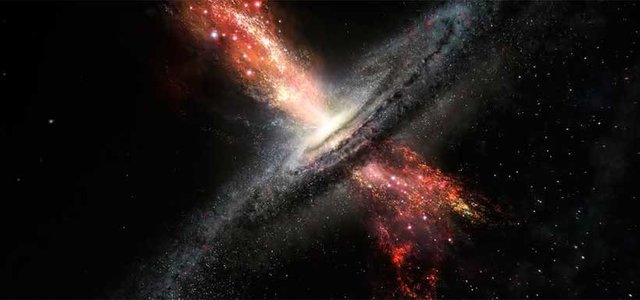
When the giant stars reach the final state of their lives they explode in cataclysms known as supernovas. Such explosion disperses most of the star to the space vacuum but there remain a great amount of cold remains in which the fusion does not take place (https://www.nationalgeographic.es/espacio/agujeros-negros). In young stars, nuclear fusion creates energy and a constant external pressure that is in equilibrium with the force of internal gravity produced by the mass of the star itself. However, in the inert remains of a supernova there is no force that resists gravity, so the star begins to fall back on itself.
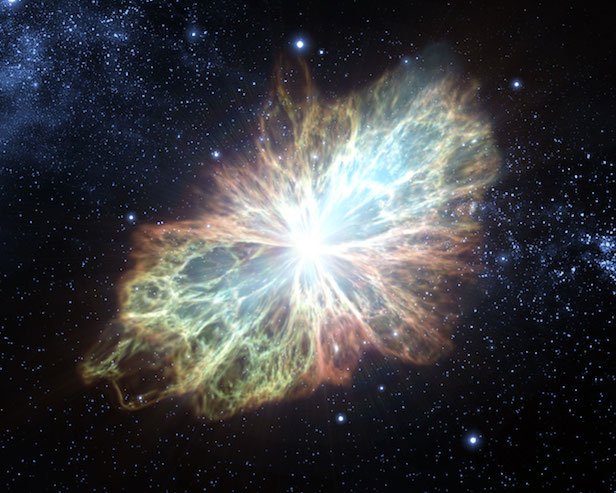
Therefore it is theoretically established that without a force that slows gravity, the emerging black hole shrinks to a zero volume, at which point it becomes infinitely dense. Even the light of said star is unable to escape its immense gravitational force, which is trapped in orbit, so the dark star is known as a black hole. However, black holes may be capable of emitting radiation, which was conjectured by Stephen Hawking in the 1970s. The radiation emitted by black holes like Cygnus X-1 does not come from the black hole itself but from its accretion disk.

The black holes come from a process of gravitational collapse that was widely studied in the mid-twentieth century by various scientists, particularly Robert Oppenheimer, Roger Penrose and Stephen Hawking among others. Hawking, in his informative book History of Time: From the Big Bang to Black Holes (1988), reviews some of the well-established facts about the formation of black holes.
As explained at the beginning of the post this process begins after the "death" of a red giant (star of 10 to 25 or more times the mass of the Sun), meaning "death" the total extinction of its energy. After several billions of years of life, the gravitational force of this star begins to exert force on itself, originating a mass concentrated in a small volume, becoming a white dwarf. At this point, this process can continue until the collapse of that star by the gravitational attraction that ends up turning this white dwarf into a black hole. This process ends up by gathering a force of attraction so strong that it catches even the light in it (https://es.m.wikipedia.org/wiki/Agujero_negro).
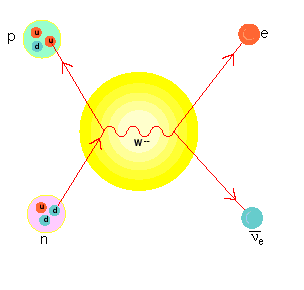
So this process would support the emission of a large number of neutrinos. The final result, a neutron star. At this point, depending on the mass of the star, the neutron plasma triggers an irreversible chain reaction, the gravity increases enormously as the distance that originally existed between the atoms diminished. The neutron particles implode, crushing more, resulting in a black hole, which is a region of space-time limited by the so-called event horizon. The details of what happens to matter that falls beyond this horizon into a black hole are not known because for small scales only a quantum theory of gravity could adequately explain them, but there is no formulation completely consistent with that theory.
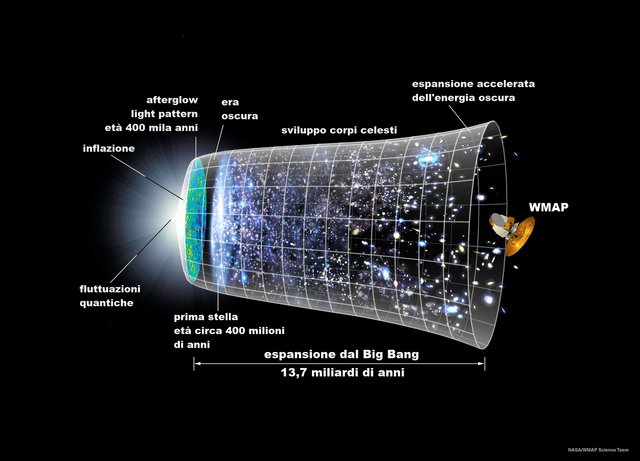
In simpler words, a black hole is the end result of the action of extreme gravity carried to the possible limit. The same gravity that keeps the star stable, begins to compress to the point that the atoms begin to collapse. Orbiting electrons get closer and closer to the atomic nucleus and eventually merge with the protons, forming more neutrons through the process:

The concept of a body so dense that even light can not escape it was described in an article sent in 1783 to the Royal Society by an English geologist named John Michell. At that time Newton's theory of gravitation and the concept of escape velocity were well known. Michell calculated that a body with a radius 500 times that of the Sun and the same density, would have, on its surface, an escape velocity equal to that of light and would be invisible. In 1796, the French mathematician Pierre-Simon Laplace explained the same idea in the first two editions of his book Exposition du Systeme du Monde although, as the idea that light was a massless wave gained ground, in the 19th century it was discarded in later editions.
In 1915, Einstein developed general relativity and showed that light was influenced by gravitational interaction. A few months later, Karl Schwarzschild found a solution to Einstein's equations, where a heavy body would absorb light. It is now known that the Schwarzschild radius is the radius of the event horizon of a black hole that does not rotate, but this was not well understood at that time. Schwarzschild himself thought it was just a mathematical solution, not a physical one. (https://es.m.wikipedia.org/wiki/Agujero_negro).
The gravity of a black hole, or "curvature of space-time," causes a singularity enveloped by a closed surface, called the event horizon. This is predicted by the equations of the Einstein field. The event horizon separates the black hole region from the rest of the universe and is the boundary surface of space from which no particle can exit, including photons. This curvature is studied by general relativity, which predicted the existence of black holes and was his first indication. In the 1970s, Hawking, Ellis and Penrose demonstrated several important theorems on the occurrence and geometry of black holes. Previously, in 1963, Roy Kerr had shown that in a four-dimensional space-time all black holes had to have a quasi-spherical geometry determined by three parameters: its mass M, its total electric charge e and its angular momentum L. (https://prezi.com/m_neplzgsmkr/agujeros-negros/?webgl=0).

The black holes have a small size. A hole of a solar mass of a million, like the one that is suspected to be in the center of some galaxies, would have a radius of about three million kilometers, that is, only about four times the size of our sun. A black hole with a mass equal to that of the sun would have a radius of three kilometers.
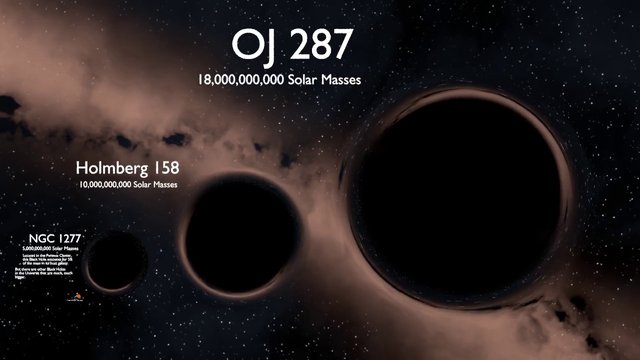
Since they are so small, distant and dark, black holes can not be observed directly. Despite this, scientists have confirmed the long-held suspicions of its existence. This is usually done by measuring the mass of a region of space and looking for areas with a large dark mass.
There are many black holes within binary systems. These holes continuously attract mass from its neighboring star, increasing the black hole and shrinking the other star, until the black hole becomes large and the companion star completely vanishes.
There may be supermassive black holes at the center of some galaxies, including our Milky Way. These immense bodies can have a mass of 10 to 100 billion suns. They are similar to smaller black holes but reach such dimensions because there is a lot of matter inside the galaxy that they can attract. Black holes can accumulate unlimited amounts of matter; they simply become even denser bodies as their mass increases.

The German theoretical physicist Albert Einstein taught us that gravity is an effect or consequence of the curved geometry of space-time. The bodies within a gravitational field follow a curved space path, even though they may actually be moving according to the most "straight" universe lines possible through a curved space-time. (http://www.bbc.com/mundo/noticias/2015/06/150531_vert_earth_que_pasa_si_caes_agujero_negro_yv).

The outer boundary of the hole is its event horizon, the point at which the gravitational force counteracts precisely the efforts of light to escape from it. To go beyond this, there would be no possible escape. The event horizon fills with energy. The quantum effects on the edge create currents of hot particles that radiate in the universe. This is known as Hawking radiation, by physicist Stephen Hawking, who predicted the phenomenon. With enough time the black hole will radiate all its mass and disappear.
The more you go into the black hole, the more curved the space will become, until, in the center, it will become infinitely curved. It is the particularity of the phenomenon. Space and time cease to be meaningful ideas and the laws of physics, as we know them, are no longer applicable.


Source and others.
There is reasonable evidence that this article has been spun, rewritten, or reworded. Repeatedly posting such content is considered spam.
Spam is discouraged by the community, and may result in action from the cheetah bot.
More information and tips on sharing content.
If you believe this comment is in error, please contact us in #disputes on Discord